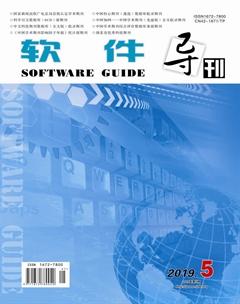基于心冲击信号的自动睡眠分期算法研究进展
段鹏慧 严加勇 段世梅
摘 要:睡眠分期是指对睡眠阶段进行分类,其是睡眠研究与睡眠相关疾病诊断的主要手段之一,具有重要的临床研究与应用价值。近年来,基于心冲击信号的自动睡眠分期算法受到研究人员的重点关注。在介绍睡眠分期和心冲击信号基本知识的基础上,详细介绍了近年来基于心冲击信号的自动睡眠分期算法,并分析该领域研究进展与未来发展趋势。
关键词:睡眠分期;心冲击信号;自动睡眠分期算法
DOI:10. 11907/rjdk. 191226
中图分类号:TP312 文献标识码:A 文章编号:1672-7800(2019)005-0005-04
Abstract:Sleep staging is the classification of sleep stages, which is essential for the diagnosis of sleep-related disorders and sleep research, and has important significance for clinical research and application. In recent years, automatic sleep staging algorithms based on ballistocardiogram(BCG) have attracted many researchers attention. On the basis of introducing the basic knowledge of sleep staging and ballistocardiogram, the present paper introduces the automatic sleep staging algorithms based on ballistocardiogram in recent years. In the end, the research progress of this field is analyzed, and development trends of next phase are pointed out.
Key Words:sleep staging;ballistocardiogram;automatic sleep staging algorithms
0 引言
睡眠與人类身体健康及生活质量密切相关,充足的睡眠可保证人体代谢正常运行,提高人体免疫力。随着社会生活节奏的加快、工作压力的增大,越来越多的人出现了睡眠不足、睡眠质量下降的情况,严重时甚至引发睡眠呼吸障碍等生理疾病,同时一些心血管疾病及精神疾病也与睡眠情况紧密相关,因此睡眠研究显得尤为重要。睡眠分期主要分析人的醒睡状态及睡眠深浅程度,是睡眠研究的主要手段之一,在睡眠质量评估与睡眠相关疾病诊断方面发挥着重要作用。
目前在临床上,睡眠分期研究主要是利用多导睡眠记录仪(Polysomnography,PSG)采集心电、脑电、眼电等电生理信号[1-12],但此类方法需要在受测人员身体多处部位固定检测电极以检测电生理信号,受测人员会有较强的束缚感,因而可能影响测试结果,且容易产生误差,而且人体多导生理信号采集过程较为复杂,对专家的经验与操作水平依赖性较强。心冲击(Ballistocardiogram,BCG)信号通过无干扰、非接触式方式采集数据,同时又包含多种生理参数,因此基于BCG信号的睡眠分期方法在此需求背景下应运而生。
1 睡眠分期与心冲击信号基础知识
在睡眠过程中,人体在各种睡眠状态下会发生不同的生理变化[13]。1968年,Rechtschaffen&Kales[14]利用睡眠时脑电图(Electroencephalogram,EEG)、眼电图(Electrooculogram,EOG)、肌电图(Electromyography,EMG)等多路生理信号进行睡眠分期,将睡眠分为6个阶段:觉醒期(Wakefulness,W)、快速眼动睡眠期(Rapid Eye Moment,REM)和4个非快速眼动睡眠期(Non-rapid Eye Movement,NREM),其中S1、S2为浅睡期(Light Sleep,LS),S3、S4为深睡期(也称为慢波睡眠期,Slow Wave Sleep,SWS)。2007年,美国睡眠医学会(American Academy of Sleep Medicine,AASM) 将R&K睡眠分期准则中的S3和S4期合成为非快速眼动3期,分为W、R、N1、N2、N3共5个阶段 [15]。不同睡眠分期方法对比如图1所示。
心脏搏动能引发身体产生相应运动,可通过高灵敏度传感器拾取该运动信号,并将其描记成波形,该波形称为心冲击信号,简称BCG信号。与心电信号(Electrocardiogram,ECG)不同,BCG获取的是人体机械振动信号,是一种非平稳的生物信号,属于低频生理信号,频率介于1~10Hz之间,幅值微弱,容易受到外界干扰,而ECG反映的是心脏兴奋的产生、传导与恢复过程中生物电的变化,两者工作方式及原理完全不同。图2、图3分别为BCG与ECG波形示意图,从图中可以看出,BCG信号主要包含H、I、J、K、 L与M、N波, J 波为峰值特征点,通常将较为明显的H、I、J、K、L作为一个I-J波群,表示一次心脏搏动,而ECG信号的一次心脏搏动主要包括P波、QRS波群和T波,其中R波为峰值特征点。两者相比,BCG信号的HIJK峰可清晰界定,同时IJK峰与ECG信号的QRS波在时间上具有一致性[16]。
2 基于心冲击信号的自动睡眠分期算法
上世纪90年代以后,随着传感器技术与电子技术的快速发展,使得对BCG信号的有效采集与分析成为可能。1991年,Jansen等[17]设计出静电荷敏感床垫(Static Charge Sensitive Bed,SCSB),发现可以从SCSB信号中获得BCG信号,这也是利用BCG信号进行睡眠监测的雏形;1996年,俞梦孙等[18]研制了微动敏感床垫监测系统,采用以小波分析为主的信号处理技术,分析24名健康受测人员心动周期的变异性,将睡眠阶段分为Wake、REM和NREM。与脑电波分析结果相比,该方式符合率达到0.852±0.048,但其仍不能对睡眠中非快速眼动期进行准确划分,从而影响对睡眠深浅的识别;Watanabe等[19]采用充气式微动敏感床垫,分析夜间睡眠中的睡眠阶段转变以及睡眠阶段与测量生理信号之间的关系,建立睡眠数学模型,并进行睡眠分期,分期结果为:NREM期、REM期与Wake期,与R&K准则的一致性分别为:82.6%、38.3%和70.5%。
近年来,多项研究工作[19-21]研究、分析了心率变异性(Heart Rate Variability,HRV)与睡眠分期之间的关系,研究表明HRV分析可以成为睡眠分期研究的基础[22-24]。HRV主要测量ECG信号的RR间期(ECG RRI),HRV分析对象包括0.04Hz-0.15Hz频率范围内的LF-HRV成分和0.15Hz-0.40Hz频率范围内的HF-HRV成分[20]。一些研究人员将HRV分析巧妙应用于基于BCG信号的睡眠分期研究[24-30]。例如,Alihanka等[24提出基于单通道静态电荷敏感床(One-channel Static Charge-sensitive-bed,SCSB)提取BCG信号和体动信号,可实现对BCG、心率、呼吸幅度和身体运动的长期连续监测;Kortelainen等[25]使用压敏传感器和倒谱方法从BCG信号中提取心跳间隔(Inter Beat Interval,IBI),与ECG RRI相比,其相对误差为0.35%,可见BCG IBI相当于ECG RRI,可将其应用于基于BCG信号的睡眠分期研究中。
截至目前,虽然基于BCG信号的睡眠分期具体算法有所不同,但基本依据是比较类似的,即睡眠深浅与心率、呼吸频率等体征具有较强关联性,如表1所示[26]。
由表1可以看出,浅睡和深睡周期可以由HR、HRV和RRV确定,REM和Wakefulness可由RRV与体动进行分辨。近年来,一些研究人员基于BCG信号进行睡眠自動分期研究,并取得了一定成果。一些典型的基于BCG信号的自动睡眠分期算法及结果如表2所示[19,27-30]。
通过对各种基于BCG信号的自动睡眠分期算法的分析,可以看出,由于对BCG信号的特征提取方法、模式识别分类器选择等均不相同,睡眠分期效果也不同。其方法大多是利用BCG信号中的HBI取代ECG中的RRI,依据心率变异性与睡眠时相的密切关系,并与呼吸频率或体动信号相结合,实现自动睡眠分期。基于BCG信号的自动睡眠分期一般过程为:首先对从微动敏感床垫中提取的BCG信号进行滤波,然后将心冲击图和对应的标准时相图按相同时间间隔进行划分,从划分得到的片段中提取特征值,将特征值对应的睡眠时相作为训练集对分类模型进行训练,从而得到睡眠时相分期结果。然而,目前基于BCG信号的自动睡眠分期算法大多只能实现对两或三个睡眠时相的划分,灵敏度与准确度较低。
3 结论与展望
睡眠分期是睡眠研究与睡眠相关疾病诊断的主要手段之一。BCG技术具备无创、非接触式以及可以长期连续监测等优点,因此是自动睡眠分期研究的一个发展方向。目前利用BCG信号进行睡眠分期研究,均是通过对信号进行滤波、统计分析或模版匹配算法分析,灵敏度和准确度较低,只能实现对两或三个睡眠时相的划分。因此,如何进一步提高分类方法的灵敏度和准确度,使睡眠时相划分更为准确,仍需要研究者们作进一步探索。
参考文献:
[1] HSU Y L,YANG Y T,WANG J S, et al. Automatic sleep stage recurrent neural classifier using energy features of EEG signals[J]. Neurocomputing, 2013, 104:105-114.
[2] 周鹏,李向新,张翼,等. 基于主成分分析和支持向量机的睡眠分期研究[J]. 生物医学工程学杂志, 2013(6):1176-1179.
[3] ZHU G,LI Y,WEN P. Analysis and classification of sleep stages based on difference visibility graphs from a single-channel EEG signal[J]. IEEE Journal of Biomedical and Health Informatics., 2014,18 (6):1813-1821.
[4] LAJNEF T,CHAIBI S,RUBY P,et al. Learning machines and sleeping brains: automatic sleep stage classification using decision-tree multi-class support vector machines[J]. Journal of Neuroscience Methods, 2015, 250:94-105.
[5] HASSAN A R,BHUIYAN M I H. Computer-aided sleep staging using complete ensemble empirical mode decomposition with adaptive noise and bootstrap aggregating[J]. Biomedical Signal Processing and Control, 2016, 24:1-10.
[6] HASSAN A R,BHUIYAN M I H. A decision support system for automatic sleep staging from EEG signals using tunable Q-factor wavelet transform and spectral features[J]. Journal of Neuroscience Methods, 2016, 271:107-118.
[7] HASSAN A R,BHUIYAN M I H. Automated identification of sleep states from EEG signals by means of ensemble empirical mode decomposition and random under sampling boosting[J]. Computer Methods and Programs in Biomedicine, 2017, 140:201-210.
[8] WEI L, LIN Y,WANG J, et al. Time-frequency convolutional neural network for automatic sleep stage classification based on single-channel EEG[C]. 2017 IEEE 29th International Conference on Tools with Artificial Intelligence (ICTAI), 2017.
[9] SILVEIRA T L T,KOZAKEVICIUS A J,RODRIGUES C R. Single-channel EEG sleep stage classification based on a streamlined set of statistical features in wavelet domain[J]. Medical & Biological Engineering & Computing, 2017, 55(2):343-352.
[10] SHARMA M,GOYAL D,ACHUTH P V,et al. An accurate sleep stages classification system using a new class of optimally time-frequency localized three-band wavelet filter bank [J]. Computers in Biology & Medicine, 2018, 98:58-75.
[11] SORS A,BONNET S,MIREK,et al.A convolutional neural network for sleep stage scoring from raw single-channel EEG[J].Biomedical Signal Processing and Control,2018,42:107-114.
[12] GHASEMZADEH P, KALBKHANI H, SARTIPI S, et al. Classification of sleep stages based on LSTAR model[J]. Applied Soft Computing,2019,75:523-536.
[13] 高群霞. 基于EEG的睡眠分期与睡眠评估方法研究[D].广州:华南理工大学, 2015.
[14] RECHTSCHAFFEN A,KALES A. A manual of standardized terminology, techniques, and scoring systems for sleep stages of human subjects[M]. Los Angeles:Brain Information Service/Brain Research Institute,University of California:1968.
[15] IBER C,ANCOLI-ISRAEL S,CHESSON A,et al. The AASM manual for the scoring of sleep and associated events: rules, terminology and technical specifications[M]. Westchester,IL:American Academy of Sleep Medicine,2007.
[16] 張先文,张丽岩,丁力超,等. 基于心冲击信号的心率检测[J]. 清华大学学报:自然科学版,2017(7):94-98.
[17] JANSEN B H,LARSON B H,SHANKAR K. Monitoring of the ballistocardiogram with the static charge sensitive bed [J]. IEEE Transactions on Biomedical Engineering,1991, 38(8):748-751.
[18] 俞梦孙,杨军,周玉彬,等. 用微动敏感床垫监测睡眠的研究[J].中华航空航天医学杂志,1999,10(1):40-45.
[19] WATANABE T,WATANABE K. Noncontact method for sleep stage estimation[J]. IEEE Ttransactions on Biomedical Engineering, 2004, 51(10):1735.
[20] PENZEL T,KANTELHARDT J W,GROTE L,et al. Comparison of detrended fluctuation analysis and spectral analysis for heart rate variability in sleep and sleep apnea[J]. IEEE Transactions on Biomedical Engineering, 2003, 50(10):1143-1151.
[21] REDMOND S J,HENEGHAN C. Cardiorespiratory-based sleep staging in subjects with obstructive sleep apnea[J]. IEEE Transactions on Biomedical Engineering, 2006, 53(3):485-496.
[22] KIM J, LEE J, SHIN M. Sleep stage classification based on noise-reduced fractal property of heart rate variability[J]. Procedia Computer Science, 2017, 116:435-440.
[23] HERZIG D,ESER P,OMLIN X,et al.Reproducibility of heart rate variability is parameter and sleep stage dependent[J].Frontiers in Physiology,2018,8:1-10.
[24] ALIHANKA J,VAAHTORANTA K,SAARIKIVI I. A new method for long-term monitoring of the ballistocardiogram, heart rate, and respiration[J]. American Journal of Physiology Regulatory, Integrative and Comparative Physiology, 1981, 240(5): 384-392.
[25] KORTELAINEN J M,VIRKKALA J. FFT averaging of multichannel BCG signals from bed mattress sensor to improve estimation of heart beat interval[C]. International Conference of the IEEE Engineering in Medicine & Biology Society, 2007.
[26] NURMI. Nocturnal sleep quality and quantity analysis with ballistocardiography[D]. Espoo:Aalto University, 2016.
[27] MIGLIORINI M,BIANCHI A M, DOMENICO N, et al. Automatic sleep staging based on ballistocardiographic signals recorded through bed sensors[C]. Annual International Conference of the IEEE Engineering in Medicine and Biology Society. IEEE Engineering in Medicine and Biology Society. Conference, 2010:3273-3276.
[28] KORTELAINEN J M, MENDEZ M O, BIANCHI A M, et al. Sleep staging based on signals acquired through bed sensor[J]. IEEE Transactions on Information Technology in Biomedicine,2010, 14(3):776-785.
[29] PARK K S, HWANG S H, JUNG D W, et al. Ballistocardiography for nonintrusive sleep structure estimation [C]. Engineering in Medicine & Biology Society. IEEE, 2014.
[30] NI H,ZHAO T,ZHOU X,et al. Analyzing sleep stages in home environment based on ballistocardiography[M]. New York:Springer International Publishing, 2015.
(責任编辑:黄 健)

